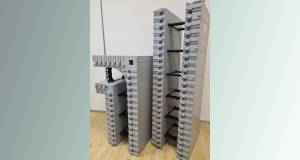
- Marketplace
- Posted
Why airtightness, moisture and ventilation matter for passive house
Ecological Building Systems technical specification advisor Dave Judd looks at airtightness, active moisture control and effective ventilation in passive house properties.
This article was originally published in issue 48 of Passive House Plus magazine. Want immediate access to all back issues and exclusive extra content? Click here to subscribe for as little as €15, or click here to receive the next issue free of charge
Unwanted air leakage significantly increases space heating requirements, while making buildings draughty, less comfortable and less energy efficient. Air leakage can also lead to long term problems in the building fabric, which can be damaged by water vapour transfer, resulting in interstitial condensation. Airtightness is therefore one of the essential components of passive house.
For passive house designers and builders, the gold standard is to achieve an air leakage rate of less than 0.6 air changes per hour (ACH) at 50 pascals of pressure difference. This stringent target ensures that the building envelope is highly sealed – minimising uncontrolled air movement and maximising energy efficiency.
Steps to airtightness
The first step to airtightness is identifying the potential areas where air leakage can occur at the design stage, including service penetrations (such as electrical wiring or plumbing connections), structural junctions or a combination of the two.
By proactively addressing and sealing these critical points, with products like Pro Clima Aerosana Visconn airtight liquid membrane, a continuous and reliable air barrier can be created. Secondly, proven airtight membranes like Pro Clima Intello Plus can be designed into the build, which responds accordingly to humidity. Intello allows over one hundred times more moisture vapour to pass through when humidity is high within the structure, increasing safety against mould and moisture-related issues.
Thirdly, high-quality air barrier tapes and sealants are crucial to ensure airtightness at joints, seams and penetrations. These specialist products are designed to withstand movement, temperature fluctuations and exposure to moisture, providing long-lasting airtightness performance. For example, Pro Clima’s core tapes have been independently evaluated with an expected life of at least one hundred years.
Quality control
Ensuring airtightness on-site requires a dedicated approach to quality control, in terms of processes and materials. Airtightness materials should have adequate certification from the Passive House Institute, BBA or other third-party test bodies. Early and frequent inspections are also essential, to identify and address any potential leaks, as well as clear communication and co-ordination among all trades involved in the construction process.
The use of an intermediate blower door test can provide valuable insights, allowing for remediation efforts to be made during the build.
Intelligent moisture management
Understanding how moisture vapour moves through different materials can help to manage it effectively to maintain the integrity of the building envelope.
Intelligent moisture management of the building fabric helps to prevent structural damage, mould growth and other moisture-related issues.
We are used to preventing moisture from entering a building from the outside, but there are many ways that moisture can enter a building from the inside. This includes convection, installing damp construction materials, vapour diffusion and flank diffusion (where water vapour bypasses a vapour barrier at a junction with a structural element (e.g. an unplastered chimney breast).
A careful balance is needed between the moisture loading of materials and ensuring sufficient drying reserves. If the moisture loading of a build exceeds the drying reserves, structural damage can occur. It’s essential to build in adequate drying reserves to prevent long term issues such as mould and structural damage.
Intelligent vapour check membranes such as Pro Clima’s Intello Plus are designed to provide humidity-variable diffusion resistance. These sophisticated internal membranes can adapt to changing environmental humidity levels, allowing the building fabric to dry out when needed while preventing excessive moisture vapour intrusion in winter months. Intello’s unique humidity variable performance has an approved service life of at least 50 years based on its European Technical Approval.
Effective ventilation
As well as airtightness, a healthy living environment also needs to have careful control of indoor humidity levels and an effective ventilation system to prevent condensation and mould growth.
An effective ventilation system is essential for maintaining a healthy indoor environment, removing harmful VOCs, regulating humidity levels and optimising energy efficiency.
Planned ventilation via mechanical ventilation with heat recovery (MVHR) or decentralised mechanical ventilation with heat recovery (dMVHR) can be very effective. These systems use a heat exchanger to capture heat from extracted air and transfer it to the incoming fresh air, reducing the need for additional heating or cooling.
An effective ventilation system strikes a balance between fresh filtered air supply versus unnecessary air supply causing excessive heat loss. It must also be able to control condensation through humidity regulation and provide heat recovery which lowers energy demand.
Since the first passive house was built in Darmstadt in 1990, products and technologies which enable advanced moisture control, airtightness and effective ventilation are more available than ever before, moving passive house from a niche to the mainstream.
In 2024, Pro Clima celebrates its 30th anniversary, and Ecological Building Systems has been the approved distributor for Pro Clima products in the UK and Ireland for over 20 years.
For more information visit www.ecologicalbuildingsystems.com.







